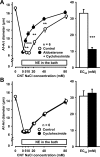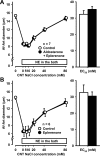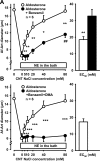Aldosterone sensitizes connecting tubule glomerular feedback via the aldosterone receptor GPR30
- PMID: 24966088
- PMCID: PMC4137129
- DOI: 10.1152/ajprenal.00072.2014
Aldosterone sensitizes connecting tubule glomerular feedback via the aldosterone receptor GPR30
Abstract
Increasing Na delivery to epithelial Na channels (ENaC) in the connecting tubule (CNT) dilates the afferent arteriole (Af-Art), a process we call connecting tubule glomerular feedback (CTGF). We hypothesize that aldosterone sensitizes CTGF via a nongenomic mechanism that stimulates CNT ENaC via the aldosterone receptor GPR30. Rabbit Af-Arts and their adherent CNTs were microdissected and simultaneously perfused. Two consecutive CTGF curves were elicited by increasing luminal NaCl in the CNT. During the control period, the concentration of NaCl that elicited a half-maximal response (EC50) was 37.0 ± 2.0 mmol/l; addition of aldosterone 10(-8) mol/l to the CNT lumen caused a left-shift (decrease) in EC50 to 19.3 ± 1.3 mmol/l (P = 0.001 vs. control; n = 6). Neither the transcription inhibitor actinomycin D nor the translation inhibitor cycloheximide prevented the effect of aldosterone (control EC50 = 34.7 ± 1.9 mmol/l; aldosterone+actinomycin D EC50 = 22.6 ± 1.6 mmol/l; P < 0.001 and control EC50 = 32.4 ± 4.3 mmol/l; aldosterone+cycloheximide EC50 = 17.4 ± 3.3 mmol/l; P < 0.001). The aldosterone antagonist eplerenone prevented the sensitization of CTGF by aldosterone (control EC50 = 33.2 ± 1.7 mmol/l; aldosterone+eplerenone EC50 = 33.5 ± 1.3 mmol/l; n = 7). The GPR30 receptor blocker G-36 blocked the sensitization of CTGF by aldosterone (aldosterone EC50 = 16.5 ± 1.9 mmol/l; aldosterone+G-36 EC50 = 29.0 ± 2.1 mmol/l; n = 7; P < 0.001). Finally, we found that the sensitization of CTGF by aldosterone was mediated, at least in part, by the sodium/hydrogen exchanger (NHE). We conclude that aldosterone in the CNT lumen sensitizes CTGF via a nongenomic effect involving GPR30 receptors and NHE. Sensitized CTGF induced by aldosterone may contribute to renal damage by increasing Af-Art dilation and glomerular capillary pressure (glomerular barotrauma).
Keywords: GPR30 receptor; MR receptor; aldosterone; arterioles; distal kidney tubules.
Copyright © 2014 the American Physiological Society.
Figures







References
-
- Arima S. Rapid nongenomic vasoconstrictor actions of aldosterone in the renal microcirculation. J Steroid Biochem Mol Biol 102: 170–174, 2006 - PubMed
-
- Barajas L, Powers K, Carretero OA, Scicli AG, Inagami T. Immunocytochemical localization of renin and kallikrein in the rat renal cortex. Kidney Int 29: 965–970, 1986 - PubMed
-
- Booth RE, Johnson JP, Stockand JD. Aldosterone. Adv Physiol Educ 26: 8–20, 2002 - PubMed
Publication types
MeSH terms
Substances
Grants and funding
LinkOut - more resources
Full Text Sources
Other Literature Sources
Miscellaneous

